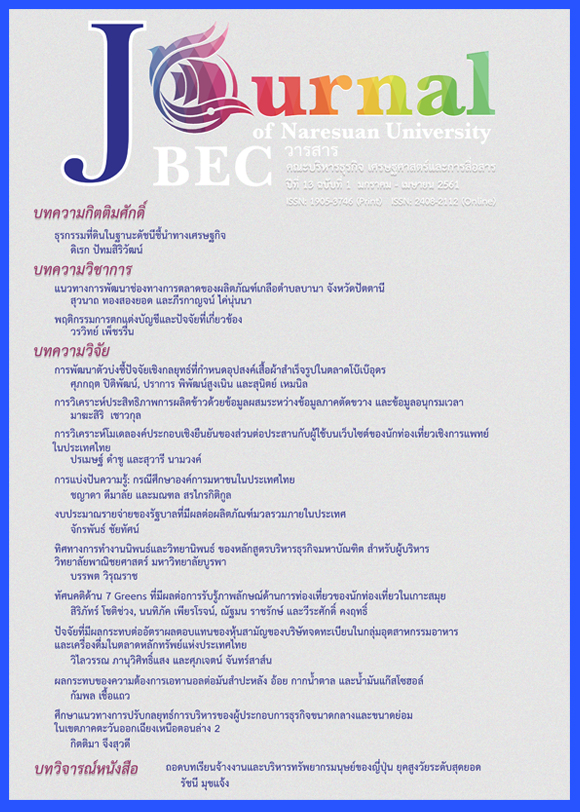งบประมาณรายจ่ายของรัฐบาลที่มีผลต่อผลิตภัณฑ์มวลรวมภายในประเทศ [The Impact of Government Budgetary Expenditure on the Gross Domestic Product]
Main Article Content
บทคัดย่อ
การวิจัยครั้งนี้มีวัตถุประสงค์เพื่อวิเคราะห์ความสัมพันธ์ระหว่างงบประมาณรายจ่ายจำแนกตามลักษณะงานกับผลิตภัณฑ์มวลรวมภายในประเทศ โดยวิธีการทางเศรษฐมิติ 4 ขั้นตอน ได้แก่ 1) การทดสอบความนิ่งของข้อมูล (Unit Root Test) คือ งบประมาณรายจ่ายด้านการเศรษฐกิจ งบประมาณรายจ่ายด้านการศึกษา งบประมาณรายจ่ายด้านการสาธารณสุข งบประมาณรายจ่ายด้านการชำระหนี้เงินกู้ และผลิตภัณฑ์มวลรวมภายในประเทศ 2) การทดสอบความสัมพันธ์เชิงดุลยภาพระยะยาว (Cointegration Test) 3) การทดสอบแบบจำลองการปรับตัวระยะสั้น (Error - Correction Model: ECM) และ 4) การทดสอบความเป็นเหตุเป็นผล (Granger Causality Test) ผลการศึกษาพบว่า ข้อมูลงบประมาณรายจ่ายจำแนกตามลักษณะงานและผลิตภัณฑ์มวลรวมภายในประเทศมีลักษณะนิ่ง (Stationary) ที่ระดับ I(1) และมีความสัมพันธ์เชิงดุลยภาพระยะยาวในทิศทางเดียวกันที่ระดับนัยสำคัญ 0.05 ในส่วนการทดสอบความสัมพันธ์เชิงดุลยภาพระยะสั้นพบว่า กรณีที่งบประมาณรายจ่ายจำแนกตามลักษณะงานเป็นตัวแปรอิสระและผลิตภัณฑ์มวลรวมภายในประเทศเป็นตัวแปรตาม แบบจำลองไม่มีการปรับตัวระยะสั้น และผลของการทดสอบความเป็นเหตุเป็นผล พบว่า งบประมาณรายจ่ายจำแนกตามลักษณะงานเป็นสาเหตุของการเปลี่ยนแปลงผลิตภัณฑ์มวลรวมภายในประเทศ โดยผลที่เกิดจากงบประมาณรายจ่ายจำแนกตามลักษณะงานมีดังนี้ เมื่อรัฐบาลเพิ่มงบประมาณรายจ่ายด้านการเศรษฐกิจ 1 ล้านบาท จะทำให้ผลิตภัณฑ์มวลรวมภายในประเทศเพิ่มขึ้น 2.627 ล้านบาท เมื่อรัฐบาลเพิ่มงบประมาณรายจ่ายด้านการศึกษาเพิ่มขึ้น 1 ล้านบาท จะทำให้ผลิตภัณฑ์มวลรวมภายในประเทศเพิ่มขึ้น 17.715 ล้านบาท เมื่อรัฐบาลเพิ่มงบประมาณรายจ่ายด้านการสาธารณสุขเพิ่มขึ้น 1 ล้านบาท จะทำให้ผลิตภัณฑ์มวลรวมภายในประเทศเพิ่มขึ้น 7.049 ล้านบาท และเมื่อรัฐบาลเพิ่มงบประมาณรายจ่ายด้านการชำระหนี้เงินกู้เพิ่มขึ้น 1 ล้านบาท จะทำให้ผลิตภัณฑ์มวลรวมภายในประเทศเพิ่มขึ้น 2.483 ล้านบาท
Article Details
เอกสารอ้างอิง
2. Bureau of the Budget. (1982-2015). Thailand’s budget in brief fiscal year 1982-2015. Bangkok: Bureau of the Budget, The Prime Minister’s Office.
3. Chaithat, C., Chomchuen, T. and Manussanit, W. (2016). An analysis of the budget expenditures appropriation for education effected on the northern region economic growth. Journal of Business, Economics and Communications, 11(2), 69-73.
4. Dickey, D. A. and Fuller, W. A. (1979). Distribution of the estimators for autoregressive time series with a unit root. Journal of the American statistical association, 74(366a), 427-431.
5. Engle, R. F. and Granger, C. W. (1987). Co-integration and error correction: Representation, estimation and testing. Econometrica: Journal of the Econometric Society, 55(2), 251-276.
6. Granger, C. W. (1969). Investigating causal relations by econometric models and cross - spectral methods. Econometrica: Journal of the Econometric Society, 37(3), 424-438.
7. Henrekson, M. (1993). Wagner's law-a spurious relationship?. Public Finance, 48(2), 406-415.
8. Jaithoum, P. (2010). An analysis of the relationship between current expenditure of government, capital expenditure of government and gross domestic product of Thailand. Independent Study, M. Econ., Chiang Mai University, Chiang Mai.
9. Loizides, J. and Vamvoukas, G. (2005). Government expenditure and economic growth: Evidence from trivariate causality testing. Journal of Applied Economics, 8(1), 125-152.
10. MacKinnon, J. G. (1996). Numerical distribution functions for unit root and cointegration tests. Journal of Applied Econometrics, 11(6), 601-618.
11. Mingmaninakin, W. (2012). Principles of economics. Bangkok: Thammasat University press.
12. Office of the Nation Economic and Social Development Board. (2017). Regional products and province. Retrieved April 10, 2017, from http://www.nesdb.go.th/more_news.php?cid= 564&filename= index
13. Sinha, D. (1998). Government expenditure and economic growth in Malaysia. Journal of Economic Development, 23(2), 71-80.
14. Sommit, R. (2007). The Role of government expenditure on the macroeconomic variables in Thailand. Master thesis, M. Econ., ChiangMai University, Chiang Mai.
15. Sukkapat, P. (2008). An analysis of relationship between public education and economic growth of Thailand. Independent Study, M. Econ., Chiang Mai University, Chiang Mai.
16. Thailand Development Research Institute. (2015). Strengths and weaknesses of Thai economy. TDRI Report, 111, 3-7.
17. Thanapatkuntorn, N. (2013). The effects of government expenditure and taxation. Independent Study, M. Econ., Chiang Mai University, Chiang Mai.
18. Vasudeva, N. R. M. (1993). Further evidence of Wagner's law for Mexico: An application of cointegration analysis. Public Finance = Finances Publiques, 48(1), 92-96.


